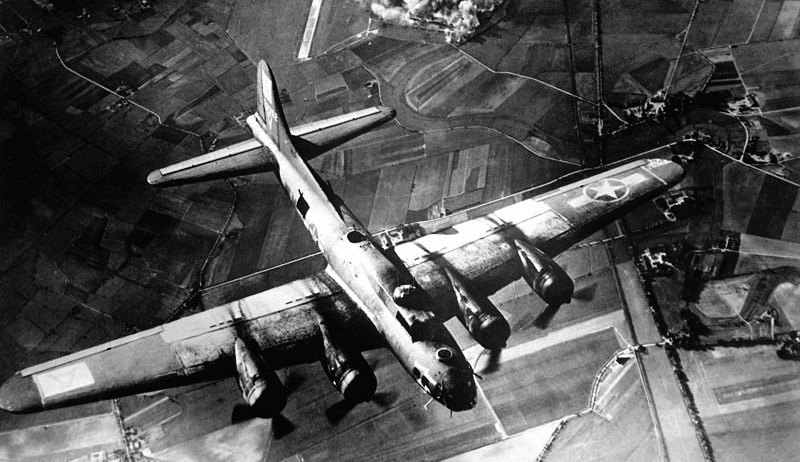I first caught wind of Fort Wayne, Indiana’s almost-obliteration after reading Michael Martone’s essay/story, “Fort Wayne Is Seventh On Hitler’s List.” As a Fort Wayne native, I was shocked by the title’s claim. Impressed, too—at least a little—that our city was once important enough to warrant Hitler’s wrath.
Admittedly, being seventh on a bombing list is a bit of a dubious honor, and as the Fort Wayne Visitors Bureau knows all too well, one that hardly translates to tourist dollars. Yet what we lack in tourism we make up for with hometown pride; the old timers are still known to puff out their chests and recount stories about the time we were nearly in Hitler’s crosshairs. So why did Hitler allegedly take an interest in our fair city?
According to said old timers, it had to do with our robust array of wartime manufacturing. During the war years, Fort Wayne was home to International Harvester, General Electric, Magnavox, Tokheim, REA Magnet Wire, and other major industries that produced everything from army trucks to airplane propellers to sonar systems. Though perhaps our most notorious contribution occurred at the Fort Wayne Rolling Mill, where citizens shaped the uranium for the first atomic bomb. Suffice it to say that Fort Wayne was a thorn in the Fuhrer’s side.
Thankfully, we were spared (assuming we were ever threatened), though Fort Wayne would come in contact with German soldiers as the result of a POW camp constructed within city limits. By 1946, Camp Scott housed six hundred German prisoners, many of whom—despite the circumstances of their arrival—were said to have thoroughly enjoyed their time in Fort Wayne. So much that they decided to stick around. Reports confirmed that while trapped behind barbwire they still managed to enjoy the occasional game of Ping-Pong, drink the occasional beer, and persuade the occasional American child to buy them a soda pop. All things considered, life was good in Fort Wayne, even for the prisoners. And life became better still when the war came to its close, the people of Fort Wayne releasing a collective sigh as a result of being spared from bombs.
Though make no mistake: we were ready for them.
A few years after reading Martone’s work, I found myself in the archives of the Fort Wayne History Center. After a bit of browsing, I came across several boxes labeled “Fort Wayne Civilian Defense Council Records, 1939-1947.” Intrigued, I dipped inside, and was soon overwhelmed with information on the city’s efforts to secure the homeland. The city was hardly alone (places all over the country made similar arrangements), but Fort Wayne’s gusto for self-defense prompted a raised eyebrow. At the war’s peak, no less than 8,142 Fort Wayne citizens volunteered for service, half of whom functioned as block wardens, whose mission it was to scan the skies in search of German planes. More surprising than this impractical duty (did we really expect the Luftwaffe to get past New York without notice?) was the even more impractical one: Fort Wayne’s theatrical efforts to spread word of our hypothetical attack.
Included in one of the archival boxes I find a script titled “Bombs Over Fort Wayne”—a joint venture of the Fort Wayne Office of Civil Defense and a local radio station. The script depicts a German air raid attack in the city’s downtown, which, seventy years later, seems laughable. Yet for citizens on edge, it was perhaps anything but.
“High explosive bombs at Calhoun and Pontiac!” shouts one character. “Casualties approximately ten. Fire in three buildings. Electric wire down.”
Within pages, officers attempt to apprehend six Nazi soldiers, thereby saving the city.
Fort Wayne’s fire chief, Carter Bowser, believed the film to be such a cinematic achievement that he attempted to sell the rights to the Office of Civil Defense in Washington, D.C. The national office politely declined. While Fort Wayne’s engineers nearly got us killed as a result of their skills, our city’s thespians, apparently, were still honing theirs.
These days, all those engineers and thespians are gone, though the legend remains. Even today, every time I go home for a holiday I find myself asking folks about Hitler’s bombing list.
Is it true? It is real? Were we really?
Walter Font, the curator of the History Center, confirms that he’s familiar with the legend, though he’s never seen any written record of our near-brush with disaster. Fort Wayne librarian John Beatty (who literally wrote the book on the city) agrees. “It’s become quite a myth,” he says. “But I’ve never seen any bombing list. Though I wonder,” he adds, “what information the Germans might have in their archives … ”
True or not, the legend lives on—as hometown legends must. What would we be without them but another blip on a map? It’s our stories that make our towns unique, and as citizens, is it not our civic duty to perpetuate such tales?
Who’s to say if Paul Bunyan really chopped down that tree, or if the monster really lives in that lake? Likewise, who really knows if Fort Wayne was seventh on Hitler’s list, or seventeenth, or if there was even a list at all? All we know for certain is that it feels good to be proud of the place that we call home. Even if on occasion the facts turn to fiction, who among us would dare destroy the stories we’ve collectively spun?
A bomb is nothing compared to an unforgiving fact. And I’ll take the fiction any day.
Image via Wikipedia.




